Mythbuster, Space Edition: Is Space a Sanctuary?
Is space a 'sanctuary?' Is there a bucolic past to which we can longingly gaze? Read this article and find out!

Is space a sanctuary? Is it the peaceful celestial ocean that we hope it is? This article reviews treaties, counterspace systems, and space history to answer this question. During this exploration, we find that:
Space was never a sanctuary; as soon as spacecraft were flown, systems were developed to degrade and destroy them. Such systems - 'Counterspace Systems,' have been developed for over 60 years, with small lulls initiated by American and Soviet arms control efforts and nuclear deterrence. The past 20 years have seen a 'bull-market' in counterspace system development and a proliferation of these capabilities beyond great powers, to include China, France, India, Iran, North Korea, Russia, and the United States (alphabetical order). The Artemis Accords offer a bright hope for the future, espousing peaceful activities and transparency in space.
To dissect this weighty and likely depressing topic, we will 1) examine the 'Space as a Sanctuary' theory and school of spacepower theory, 2) define counterspace systems, their modalities, and types of effects, and 3) review the history of counterspace systems and their likely near future. Even with rigorous and merciless pruning, this article is a long one.
Let's begin with the uplifting part.
1) Space as a Sanctuary
The Dream
The 1967 Outer Space Treaty exemplifies our best and most peaceful endeavors to ensure that only the noblest aspects of human activities propagate into the space domain.
"The exploration and use of outer space, including the moon and other celestial bodies, shall be carried out for the benefit and in the interests of all countries, irrespective of their degree of economic or scientific development, and shall be the province of all mankind." (Article 1, Outer Space Treaty)
There are many other substantive declarations in the United Nations Outer Space Treaty. I refer the interested reader to the source material. The key takeaway is that both the United States and the Soviet Union signed this treaty.

In the eyes of the American public, the Outer Space Treaty has become the clarion call and anthem of civil space exploration pursued by the National Aeronautics and Space Administration (NASA). NASA articulates this dream in their mission statement:
"NASA explores the unknown in air and space, innovates for the benefit of humanity, and inspires the world through discovery." (Our Mission & Values, NASA)
In the realm of astropolitics, ideals and values are tested against other national actors who may or may not share interests in the space domain. The 'Sanctuary' school of spacepower theory carries the spiritual banner of the Outer Space Treaty. Let's discuss how it does so.
The Space Sanctuary School of Spacepower
Spacepower Theory involves how national instruments of spacepower can be used to ensure prosperity and security of nations. When determining how to attain security and prosperity, there are several 'schools' of thought in spacepower theory - just as there are several approaches in other domains (maritime, air, land, etc.).
Borrowing from a recent article describing different Schools of Spacepower Theory:
"[T]he Sanctuary School depends upon deterrence to ensure that space is a war-free zone devoid of weapons. This line of thought formed the basis of the first space policies implemented during the Eisenhower administration." (An Astronautical Engineer's Spacepower Theory Reading List)
Col. Lupton summarizes the connection between the Sanctuary School and nuclear deterrence.
"According to its advocates, the primary value of space forces is their ability to reduce the probability of global nuclear war." (pg. 21, On Space Warfare: A Space Power Doctrine)
These are all laudable purposes for pursuing the 'Space as a Sanctuary' on-orbit reality. This begs the question: has it worked?
The Reality
To those unaware of on-orbit events over the past decades, the reality of adversarial activities on-orbit is stark and unpleasant. This is particularly true given that one of the purposes of 'Space as a Sanctuary' is to ensure stable nuclear deterrence.
Nevertheless:
"Decades of jamming, lasing, and other directed energy attacks against satellites or the signals they carry, precede this book. Such attacks have become commonplace in both war and peace, but no one talks about them." (Loc 88, Reversing the Tao)
Why don't we hear more about these nefarious activities? In his book Reversing the Tao, author Christopher Stone proposes four reasons (the link is for the 2015 thesis). Let's discuss each.
First, conservatives never like sharing information about space attacks because they fear doing so may expose vulnerabilities that adversaries could exploit later." (Loc 91, Reversing the Tao)
True enough and justifiable. Classification and information restriction exist for a reason.
Second, liberals persist in propagating the sanctuary myth because they fear disclosing information about space attacks will entice more actors to develop their own counter-space programs." (Loc 92, Reversing the Tao
We'll define 'counterspace systems' in the next section. After reading the remainder of this article I'll leave it to the reader to determine whether 'space as a sanctuary' is a myth.
Third, commercial satellite operators remain quiet because they fear losing money if their customers lose confidence in their ability to assure services." (Loc 93, Reversing the Tao)
This seems plausible - commercial entities have strong incentives built into their profit motive.
Finally, members of the arms control community, who mean well, but whose valiant attempts to put the genie back in the bottle through treaties, codes of conduct, and rules of the road have failed, but they fear the situation will worsen if they concede defeat." (Loc 94, Reversing the Tao)
Clearly, some believe that arms control has failed in space. Another approach views arms control (and conflict) in space as a continuum, rather than a binary outcome. In the 1999 book Unrestricted Warfare, Chinese People's Liberation Army (PLA) Senior Colonels Qia Liang & Wang Xiangsui suggest that such conflict continuums be pursued in all domains, including space, and not simply within traditional arenas of international conflict.
In the following sections I'll discuss 'counterspace capabilities' and review historical infringements upon the ideals in the Outer Space Treaty.
2) Counterspace Capabilities
Counterspace systems are engineered platforms that can surveil, interfere, degrade, damage, or destroy space assets and infrastructure. If that sequence of verbs, from surveil to destroy, seems like it has a lot of grey zones, that's because it does.

In Challenges to Security in Space, published by the Defense Intelligence Agency (DIA) in 2022, counterspace threats are viewed as a continuum.
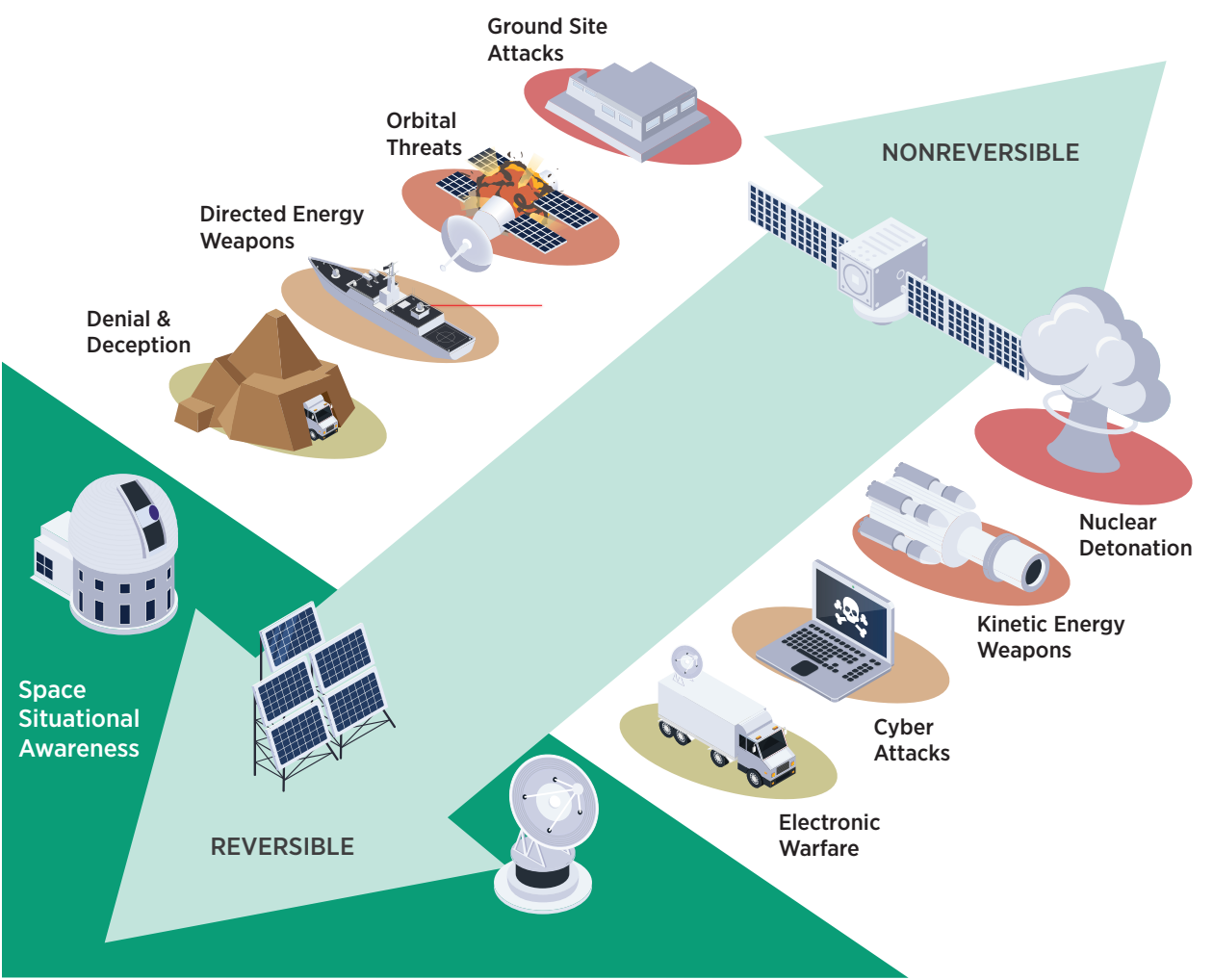
In this abstraction counterspace systems vary from entirely reversible (and in some cases compatible with civil activities, such as space traffic management) to nonreversible. Let's discuss each in more detail.
Reversible
Space Domain Awareness (SDA) systems are the most benign technologies in the counterspace spectrum. Because they are tasked with asking questions, data collection, and knowledge generation, SDA systems are foundational to ensuring treaty compliance and instrumental in any potential conflict in space.
Other systems include laser ranging, laser dazzling (a difference of power and targeting), cyber attacks, and communications / electronic warfare facilities or platforms. Reversible activities such as these creep up the conflict spectrum, deny or degrade the use of space assets or infrastrucutre, but do not generally cause permanent harm to the hardware. Political harm is another story.
Many reversible counterspace systems use dual-use technologies, meaning that they could conceivably be used for either peaceful purposes or used within the conflict spectrum.

As a recent example, a Chinese weather satellite used a green laser as an instrument near Hawaii. Discerning whether this satellite is a dual-use system is difficult, to say the least.
Because reversible counterspace activities don't cause lasting damage, can be difficult to attribute, and are very hard to litigate against, they are a favorite 'grey zone' tactic in space. The 'grey zone' nature and difficulty of attribution of reversible counterspace activities have made them endemic to the space domain.
Nonreversible
At some point counterspace systems begin to inflict actual damage to platforms or infrastructure. This threshold separates reversible from nonreversible counterspace activities. Using irreversible counterspace systems against another nation's assets puts us all onto a Kenny Loggins highway to the danger zone.

Joking aside (this topic is heavy), irreversible activities include high-energy lasing, cyber attacks, kinetic antisatellite (ASAT) weapons, and nuclear detonations. These high-stakes counterspace systems directly impact national security and nuclear deterrence. Any usage of irreversible counterspace systems will have everyone checking their escalation ladder doctrines. Conflict escalation in space or elsewhere would likely ensue. Potentially up to and including nuclear actions. Consequences would be real and grave.
So far, nonreversible counterspace system use against adversaries has served as a bright red line.
See the RAND paper The Nature of Escalation for a review of conflict escalation between nations.
3) Counterspace History and Escalation
With the sobering specter of escalation hovering over the use of counterspace systems, a natural question to ask is why anyone would want to develop them.
Why Nations Develop Counterspace Capabilities
Access to space and space assets enable nations to exercise economic, intelligence, and military instruments of national power. Application of space capabilities is often deeply asymmetric - favoring those nations that posses space capabilities.
Publicly available commercial images from satellites underline this fundamental truth.
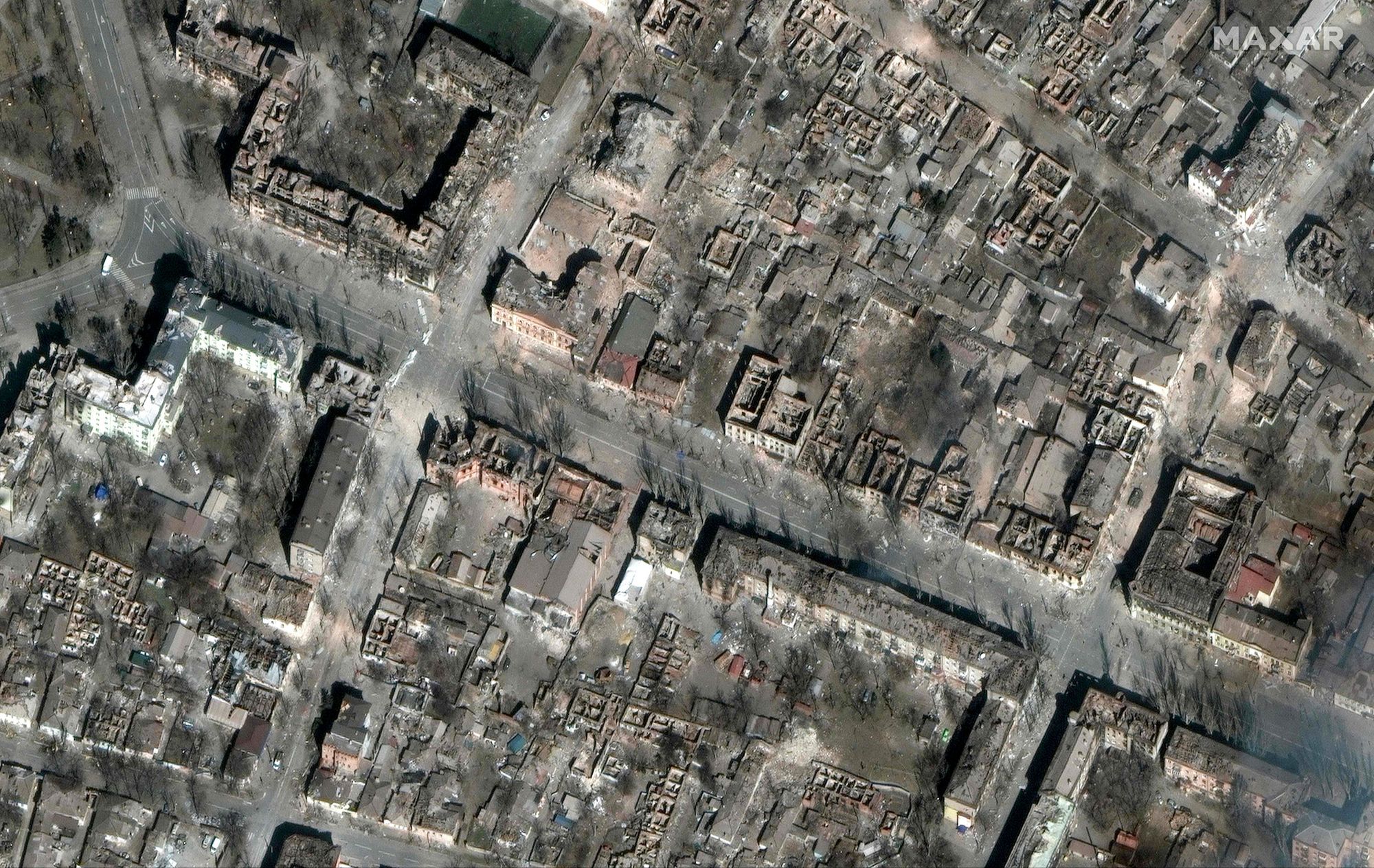
If space assets are valuable in the spectrum of human conflict - from treaty verification to shooting wars - then counterspace systems will have utility and be desired. Said differently, if space systems have value, so do counterspace systems.
"China and Russia value superiority in space. As a result, they will seek ways to strengthen their space and counterspace programs, and determine ways to better integrate them into their respective militaries." (pg. 40,
Challenges to Security in Space)
There is contention as to whether spacepower theorists should view space as an Offense Dominant Domain. If the space domain is 'offense dominant,' meaning that offensive actions are easier or less costly than defensive actions, then this would encourage development of counterspace systems further.
So far we've defined counterspace systems and discussed why nations may wish to develop them. Let's briefly review how they've been used in the past.
A Selected History of Counterspace Activities
A History of Anti-Satellite Programs gives an excellent historical summary of counterspace system testing. An comprehensive open-source summary and current status of counterspace activities is maintained by the Secure World Foundation on their Global Counterspace Capabilities page. The latest annual version, the 2022 Global Counterspace Capabilities: An Open Source Assessment, paints an uncomfortable picture.
It can be instructive to understand when various counterspace systems were first tested.
Spoiler alert - counterspace systems were developed concurrently with space technology. There is no bucolic past without counterspace systems to which we can longingly gaze.
Kinetic antisatellite (ASAT) systems were developed and tested by the United States beginning in 1959. The first successful kinetic intercept was using the Nike Zeus system in 1962. Interestingly, in the 60s and 70s the United States did not engage in debris-causing events - they counted a successful intercept if the target was within its kill radius (pg. 14-01, 2022 Global Counterspace Capabilities: An Open Source Assessment).
Soviet ASAT tests began in 1963 with a successful kinetic intercept in 1986 of Cosmos 248 culminating in generating 253 tracked space debris. American ASAT testing in the 80s changed success criterion, intercepting and destroying the Solwind satellite and creating 285 trackable debris fragments. The United States and Soviets have each launched 34 ASAT tests, though not all generated debris (pg. 14-01, 14-02, 2022 Global Counterspace Capabilities: An Open Source Assessment,). 1987 saw the failed launch of a Soviet 'Battlestation.' This program was later cancelled by Gorbechev (pg. 5, A History of Anti-Satellite Programs).
China has engaged in 10 ASAT tests. Their first debris-generating test in 2007 on their FengYun 1C satellite produced 3,527 fragments, 2,763 of which remain in orbit now. India has tested ASAT systems twice. In 2019 Microsat-R was targeted and intercepted. Thankfully, it was in low-Earth orbit and debris quickly deorbited. (pg. 14-03, 14-04, 2022 Global Counterspace Capabilities: An Open Source Assessment,)
Nuclear detonations in space began in 1961 with both Soviet and United States programs. Russian nuclear tests in space occurred in 1961 with the 88 Groza test, followed by the much higher 115 Grom test. In 1962 the United States Starfish Prime nuclear detonation in space led to American understanding of electromagnetic pulse (EMP) phenomena and their impact on electronics. This test actually disrupted electronics in Hawaii - including the Kauai telephone exchange.
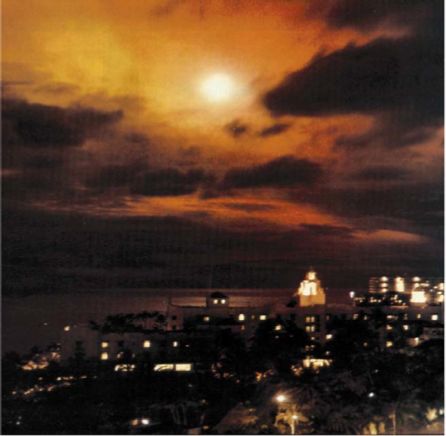
I'll insert a timely note that the 1967 Outer Space Treaty followed the nuclear detonations in space and first rounds of American and Soviet ASAT testing. There was a meaningful pause in counterspace system development tied directly to the Space Sanctuary school of spacepower theory. As a reminder to the reader, this school of spacepower theory ties the safety and sanctity of space to nuclear deterrence and mutually assured destruction. This counterspace systems lull lasted for ~15 years until the early 80's.
Lasers, Microwaves, and Electronic Warfare counterspace systems saw development starting in the 1980s with the American Strategic Defense Initiative and concurrent Soviet laser ASAT systems. These included the development of the Soviet Sary Shagan Laser-Ranging Facility in Kazakhstan and the American Mid-Infrared Advanced Chemical Laser (MIRACL) (pg. 6, A History of Anti-Satellite Programs).
In the recent past the collapse of the Soviet Union led to a another decrease in counterspace systems development that lasted through the early unipolar world of the 1990s. However, the early 2000s saw a renewal in counterspace systems and the entrance of a new set of nations developing them. The modern American Ballistic Missile Defense system was initiated in 2002.
Since then, development and testing of counterspace systems has been pursued by China, France, India, Iran, North Korea, Russia, and the United States. Australia, Japan, South Korea and the United Kingdom have developed Space Domain Awareness capabilities (all listed in alphabetical order, pg. xiii, 2022 Global Counterspace Capabilities: An Open Source Assessment).
Counterspace systems have proliferated. The figure below indicates the type and quantity of counterspace systems deployed by each nation.
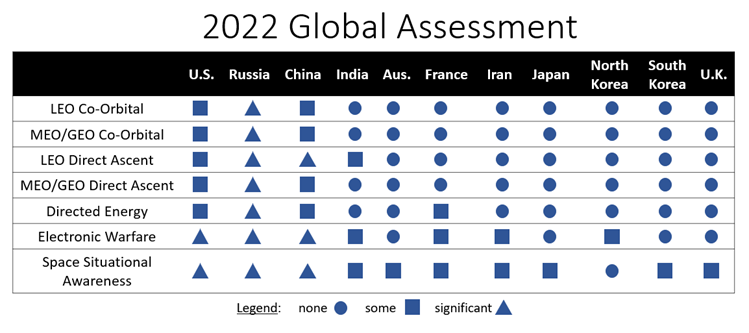
The (Near) Future of Counterspace
I'm afraid the prognosis for counterspace system proliferation doesn't look much better. According to the Secure World Foundation:
"[A]n increasing number of countries are looking to use space to enhance their military capabilities and national security. The growing use of, and reliance on, space for national security has also led more countries to look at developing their own counterspace capabilities that can be used to deceive, disrupt, deny, degrade, or destroy space systems." (pg. xii, 2022 Global Counterspace Capabilities: An Open Source Assessment)
The Defense Intelligence Agency agrees:
"The combination of increasing counterspace capabilities—especially those of China and Russia—a general growth in numbers of space objects, and the proliferation of requirements for space-enabled services will make space an increasingly competitive and crowded environment for the foreseeable future" (pg. 40, Challenges to Security in Space)
The Secure World Foundation provides some insight as to why this trend is strengthening:
"A key driver in the proliferation of offensive counterspace capabilities is the increased use of space in conventional warfare. For much of the Cold War, space was limited to mainly a strategic role in collecting strategic intelligence, enforcing arms control treaties, and warning of potential nuclear attacks. [...] [T]he close link between space capabilities and nuclear war provided a level of deterrence against actual attacks on space systems." (pg. xxx, 2022 Global Counterspace Capabilities: An Open Source Assessment)
The 'Space as a Sanctuary' approach served during the Cold War. What about now?
"However, over the last three decades, many of these strategic space capabilities have found new roles by directly supporting conventional wars by providing operational and tactical benefits to militaries. This has increased the incentives for countries to develop offensive counterspace capabilities, while also decreasing the deterrent value of the nuclear link." (pg. xxx, xxxi, 2022 Global Counterspace Capabilities: An Open Source Assessment)
Indeed - a pillar of the 'Space Sanctuary' school of spacepower theory, space-based monitoring and nuclear weapon deterrence, may be a leaning tower of Pisa. Christopher Stone says:
"First strike stability, escalation decision ladders, and deterrence all must be re-invented, given the offense dominant nature of space and the destabilizing nature of [great power competition]." (Loc 1262, Reversing the Tao)
This is deeply concerning; I prefer stable systems of nuclear deterrence. We appear to be at the dawn of an era of renewed great power competition. In that context, the temptation to develop more counter space systems is intense.
"The existence of counterspace capabilities is not new, but the circumstances surrounding them are. Today there are increased incentives for development, and potential use, of offensive counterspace capabilities. There are also greater potential consequences from their widespread use that could have global repercussions well beyond the military, as huge parts of the global economy and society are increasingly reliant on space applications." (pg. xii, 2022 Global Counterspace Capabilities: An Open Source Assessment)
The Secure World Foundation calls urgently for renewed multi-national discussions on counterspace system development.
One bright note are the multi-national Artemis Accords proposed by NASA, which double-down on principles of peace and transparency laid down in the 1967 Outer Space Treaty. The Artemis Accords have gained traction in recent years, and I sincerely hope they will continue to do so.
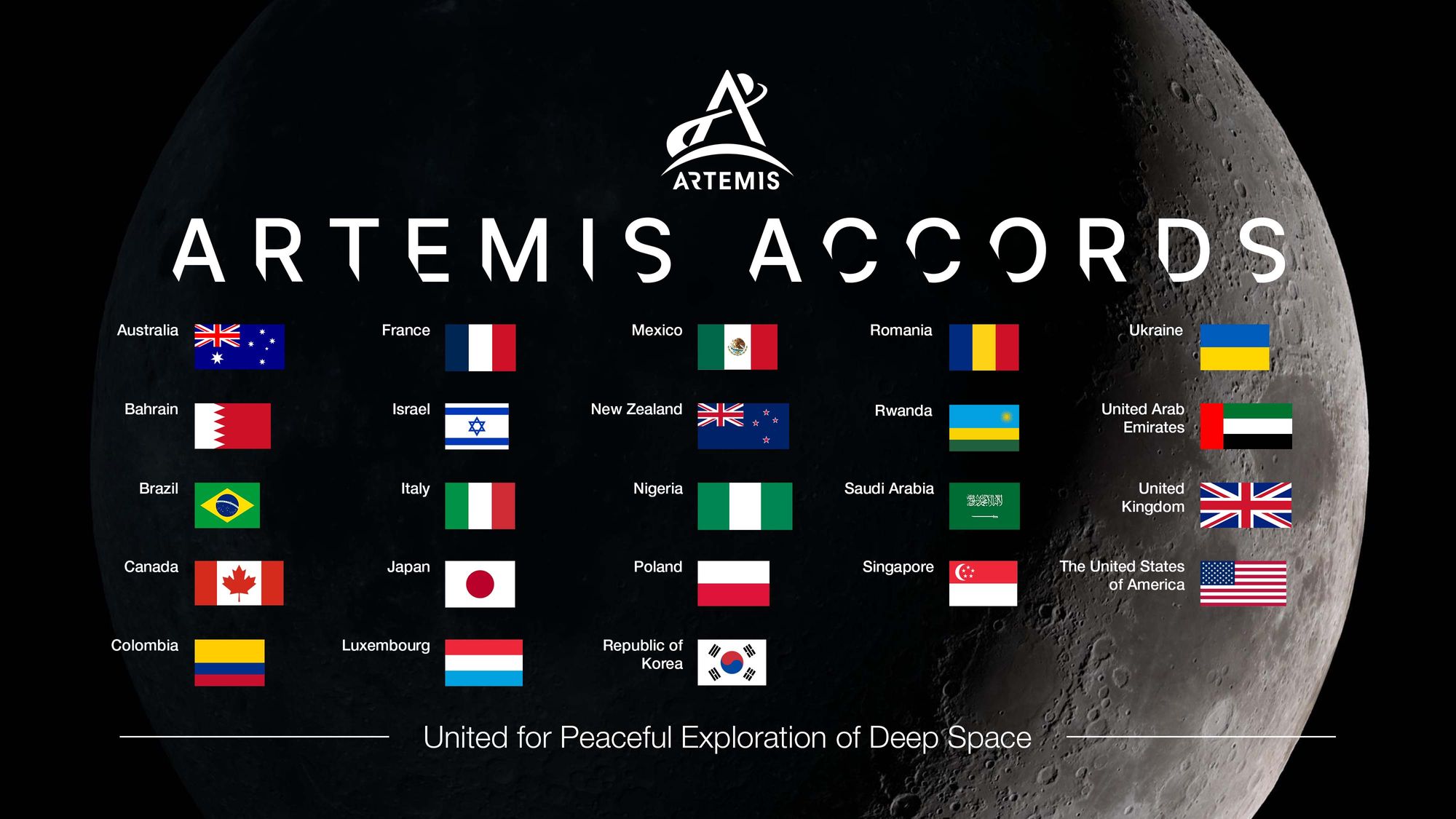
Summary
We began this article asking whether space is a 'sanctuary.' Reviewing counterspace definitions, treaties, history, and the current zeitgeist, we arrive at several unpleasant conclusions.
- Space was never a sanctuary; counterspace systems were developed and tested in tandem with space technology.
- Cold War nuclear deterrence made space almost safe from the late 60s to the early 80s. The 1983 Strategic Defense Initiative increased counterspace system development for a few years. However, the subsequent collapse of the Soviet Union led to a small lull in the 1990s.
- Counterspace systems development is in a 20-year bull-market with no sign of slowing down. Counterspace systems have proliferated and current geopolitics (astropolitics?) incentivize nations to continue developing and deploying such systems. China, France, India, Iran, North Korea, Russia, and the United States possess counterspace capabilities.
- Counterspace systems are leading to instability in nuclear deterrence; Cold War era doctrine on nuclear deterrence depends upon space-based assets. Proliferated and excessive use of counterspace systems - reversible or nonreversible - places early warning systems in danger.
- NASA and the Artemis Accords are helping to tamp down the flames of further counterspace systems development.
Subscribe to the Newsletter
If you enjoy this content, show your support by subscribing to the free weekly newsletter, which includes the weekly articles as well as additional comments from me. There are great reasons to do so, and subscriptions give me motivation to continue writing these articles! Subscribe today!


